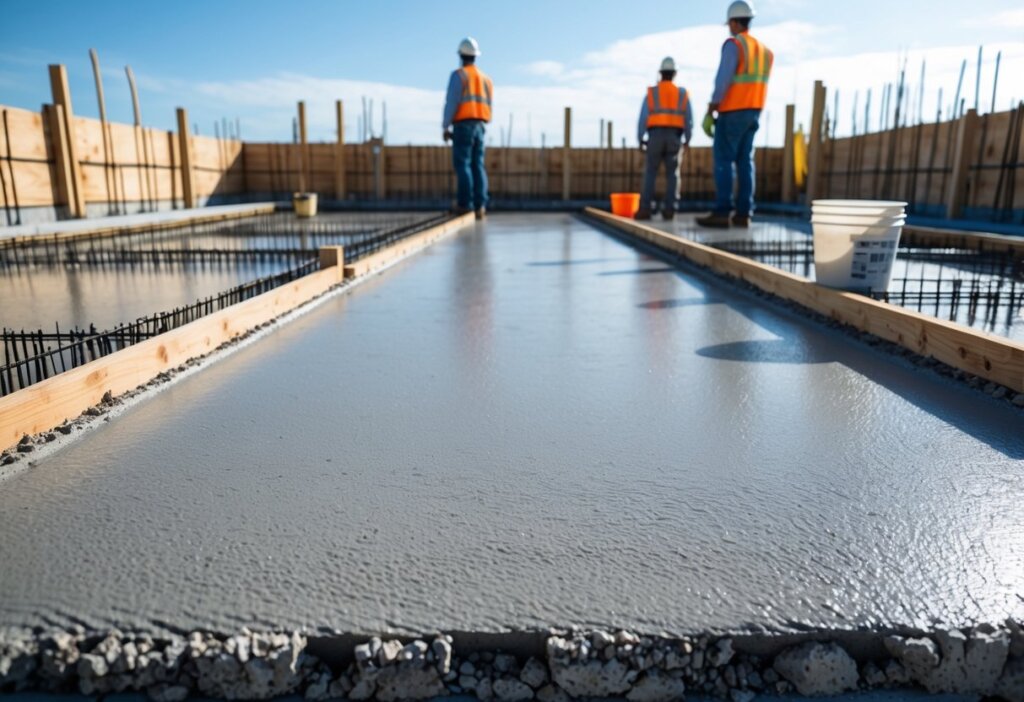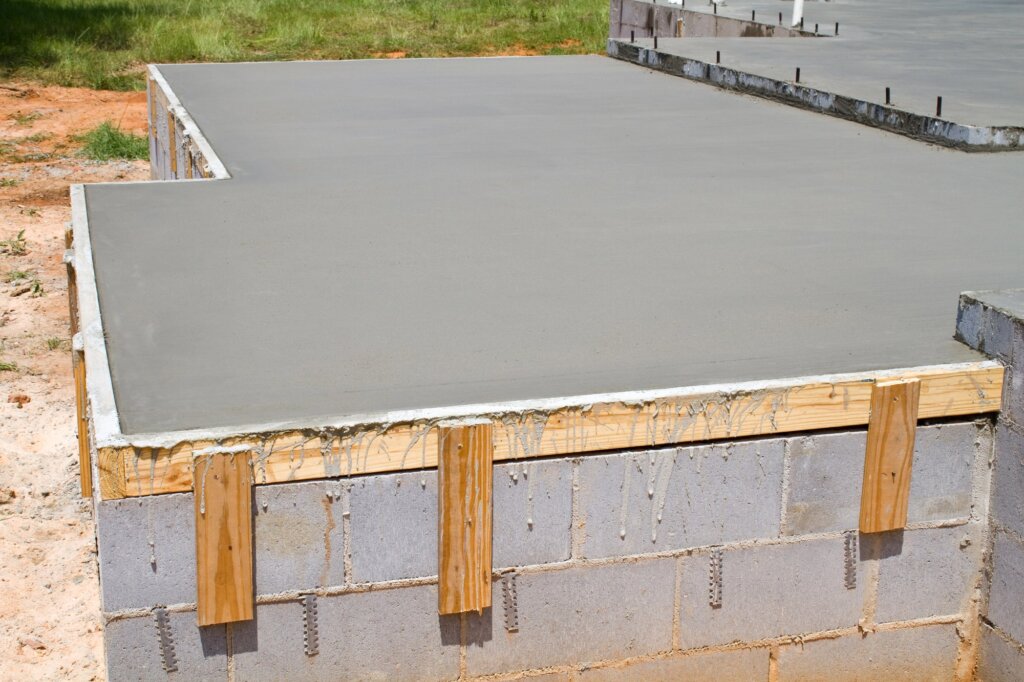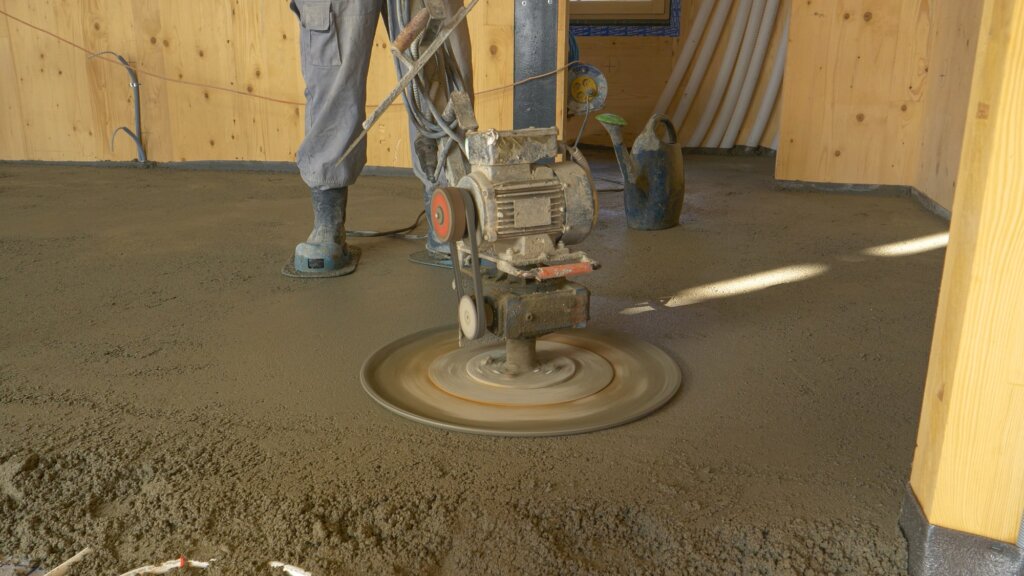Waiting for concrete to dry can feel endless, especially when you’re itching to keep things moving. Most concrete is dry enough to walk on after 24 to 48 hours, but it doesn’t reach full strength until about 28 days have passed. That gap between “looks dry” and “actually cured” is something every DIYer or contractor should keep in mind.

Knowing how long does concrete take to dry helps you avoid damaging new surfaces or building too soon. For smaller projects like sidewalks, you might be able to walk on the concrete after a day or two, but for bigger jobs such as foundations, you’ll need a bit more patience.
Before you start moving things onto fresh concrete, it’s good to know what “dry” really means. Sure, the top might feel solid, but the layers underneath are still hardening. That’s important—jumping the gun can lead to cracks and headaches later.
Understanding Concrete Drying And Curing
Concrete drying and curing are both crucial, but they’re not quite the same thing. Moisture levels and proper cure time make a big difference in how tough your concrete turns out.
Difference Between Drying And Curing
Drying and curing get mixed up a lot, but here’s the gist: drying is about water leaving the surface, while curing is the chemical reaction that makes the slab harden as it reacts with water.
Curing keeps the concrete damp so the reaction can keep going. Skip this, and you risk cracks or weak spots. Usually, you can walk on concrete after 24 to 48 hours, but curing takes way longer.
Drying is all about the surface. Curing, though, is what builds strength deep inside. Good curing helps your slab stand up to weather and wear—something you definitely want.
How Moisture Level Affects Drying
Moisture is a big deal for both drying and curing. If there’s too much water in the mix, drying slows down. A wet surface for too long can mess up the finish and leave the concrete looking blotchy.
On the flip side, if concrete dries out too fast, curing can’t do its job. That’s when you get surface cracks and weak spots. Covering the concrete or misting it with water helps control moisture loss.
Plastic sheets or curing compounds trap moisture in, keeping humidity levels just right. That way, concrete can harden properly and reach its true strength.
The Importance Of Cure Time
Cure time is how long you need to keep concrete moist so the chemical process can finish up. Cut it short, and you’ll get cracks and weak spots. Most pros suggest at least 28 days.
During this time, try to keep the temperature steady and don’t let the surface dry out. That’s your best shot at concrete that’ll last and take a beating.
Factors Affecting How Long Concrete Takes To Dry

There’s no one-size-fits-all answer—mix design, weather, and slab thickness all play a part in how fast concrete dries. Sometimes, the weather alone can change everything.
Concrete Mix Design And Water-Cement Ratio
The recipe matters. If your mix has more water compared to cement (the water-cement ratio), it’ll take longer to dry. Less water means a faster set and a tougher slab.
Additives or accelerators can speed things up or slow them down, depending on what you use. Big chunks of gravel in the mix will also change how water moves through the slab. Picking the right mix is a big deal for timing and the final look.
Thickness And Type Of Concrete Slab
Thicker slabs dry way slower than thin ones. Water in a thick slab takes longer to reach the surface and evaporate. A sidewalk might dry in a couple days, but a foundation slab could stay damp for weeks.
The slab’s type matters, too. Decorative overlays or thin pours dry quicker than thick, reinforced slabs. If your slab is more than a few inches thick or has a lot of steel, be ready to wait longer.
Temperature And Weather Conditions
Weather’s a huge factor. Warm, dry, and breezy days help concrete dry faster because water evaporates quickly. On the other hand, cool or humid conditions slow everything down.
Rain in the first few hours? That can mess up your slab and keep it wet for much longer. Freezing temps might even bring curing to a halt. If you can, try to pour concrete when the weather’s mild and steady.
Curing Concrete In Cold Weather
Curing concrete in cold weather is tricky and takes longer. Cold slows the chemical reaction between cement and water, which is what builds strength. Sometimes you’ll need thermal blankets or heaters just to keep the surface warm enough.
Too much water can freeze, leading to cracks or soft spots. If you can, pour when it’s warmer or use mixes made for cold temps. Keeping an eye on things and using covers will help you hit the right strength and drying time.
Stages Of Concrete Drying And Strength Development
Once poured, concrete goes through several stages, each one affecting how tough and long-lasting your surface will be.
Initial Setting And Surface Hardening
Right after pouring, concrete is soft and workable. Within a few hours, it starts to harden—that’s the initial set. At this point, you can’t easily leave marks with your finger.
Usually, you can walk on new concrete after 24 to 48 hours. Just don’t put anything heavy on it yet. Surface hardening means the top can take light foot traffic, but the inside is still curing.
Weather and moisture make a difference. Cooler temps slow things down, while warm, dry days speed them up. Keeping the concrete damp helps prevent cracks and builds strength.
Achieving Full Strength
Concrete doesn’t hit its full strength right away. It keeps curing and getting tougher for weeks. Hydration—the chemical process—continues as long as there’s moisture inside the slab.
Most concrete reaches full strength after about 28 days. For something like a driveway, you can usually park a car on it after a week, but heavy loads should wait until that 28-day mark. Rushing it can mean cracks or surface issues. Covering the slab with plastic or using a curing compound helps lock in moisture.
Testing Concrete Drying And Cure Progress
Want to know if your concrete’s ready? There are a few ways to check. A rebound hammer can test surface hardness. Labs crush concrete cylinders or cubes to measure strength, letting you know if your project’s at the right PSI.
Moisture tests are key, especially if you plan to add flooring or coatings. Too much moisture under a floor can wreck adhesives or finishes. Wait until moisture levels drop into the safe zone before moving forward.
Keeping notes on temperature, humidity, and test results helps you decide when it’s safe to continue. Not sure? Testing is always a safe bet.
Best Practices For Curing Concrete
Curing concrete the right way prevents cracking, dusting, and weak spots. Using good methods and dodging common mistakes means your concrete will last and hold up, even when it’s cold out.
Methods For Effective Concrete Curing
Keeping concrete moist while it cures is the secret to max strength. The most common curing methods are:
- Water Curing: Sprinkling or spraying water on the slab keeps it damp. Wet burlap or plastic sheets work too—they lock in moisture.
- Sealing: Curing compounds block water from escaping. Spray or roll them on right after finishing the surface.
- Covering: Plastic film or curing blankets (especially in cold weather) help protect against freezing and moisture loss.
Try to keep the surface damp for at least 7 days. If it’s cold, throw on extra insulation or thermal blankets to avoid freezing. Letting concrete dry out too soon can mean cracks and weak spots.
Common Mistakes And How To Avoid Them
Letting concrete dry out too quickly is a classic misstep. It messes with curing and often leads to shrinkage cracks. People also sometimes walk on or put weight on fresh concrete before 24–48 hours have passed, which can mess up the surface.
Don’t pull off curing covers too soon—especially if it’s windy or the air’s dry. Skipping the whole wet curing process or leaving the new slab exposed interrupts hydration and leaves you with weaker concrete.
Pouring concrete in winter? Watch out for frozen ground or the risk of freezing before it sets. Always check the temperature and use insulation when needed. Stick to recommended curing times: about 7 days for most things, up to 28 if you want it at full strength.
Frequently Asked Questions

Concrete needs a little TLC in those first hours and days after pouring. Weather, moisture, and when you first walk or drive on it all matter more than you might guess.
Can I walk on concrete after 12 hours?
Honestly, no—you shouldn’t walk on fresh concrete after just 12 hours. Most pros say to wait at least 24 to 48 hours. That gives the surface time to harden up and helps you avoid marks or random damage.
How soon after concrete is poured should you water it?
Start gently spraying water on concrete about 24 hours after pouring. Keeping it damp for the next week helps it cure stronger and keeps cracks away. Don’t go overboard—a gentle mist is enough, or you might wash off the top layer.
Is it okay if it rains after pouring concrete?
Rain right after pouring concrete is bad news. If the forecast looks wet in the first 24 hours, cover the fresh slab with plastic or a tarp as soon as you can. Even though concrete starts to set up in a day, it actually needs weeks to reach full strength. There’s a good Reddit discussion about this if you want more details.
Can you drive on concrete after 1 day?
Driving on fresh concrete after just one day? Not a good idea. While you can usually walk on it after 24 to 48 hours, vehicles—cars, trucks, whatever—really need to stay off for at least a full week. Concrete keeps getting stronger for weeks, honestly, so if you can wait longer before rolling over it, that’s even better.
